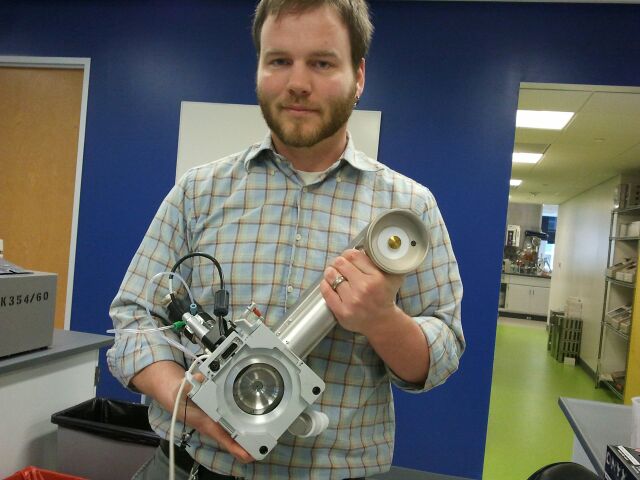ISB Innovation in Action
 isbscience.org/news/2012/05/08/isb-innovation-in-action/
isbscience.org/news/2012/05/08/isb-innovation-in-action/
Above: Kristian Swearingen and the re-engineered FAIMS device.
(Editor's Note: This post shows a wonderful example of the collaborative, innovative and entrepreneurial ethic that ISB nurtures. Even if the science or technology is difficult to explain concisely, the cross-disciplinary and integrative nature of how our work is done and the pioneering spirit come through. How cool is that?)
By Terry Farrah
What do you do when your mass spectrometer accessory doesn't do what you want right out of the box? You re-engineer it yourself — or, better, find a postdoc to do it for you. That's what my boss, Rob Moritz, chose to do two years ago when he submitted a proposal to the National Science Foundation to develop the technology. Upon being awarded the grant, he obtained a standard FAIMS device from Thermo-Fisher to hook onto an Orbitrap mass spectrometer. There was no current way to couple it with the nanoLC columns and low flow rates used in proteomics, so he set about assembling a team to do this.
FAIMS, or high-Field Asymmetric waveform Ion Mobility Spectrometry, takes complex samples containing multiple peptides (protein molecule fragments) and separates them according to their mobility in alternating electric fields. Kristian Swearingen, an Alaska native who'd just gotten his PhD at the University of Washington, accepted Dr. Moritz's challenge and joined ISB to make FAIMS work for proteomics.
Proteomics is the study of the collection of proteins in an organism, and mass spectrometry is today's primary proteomic technology (see my previous post for details). A mass spectrometer can effectively measure only one peptide species at a time, so a key challenge is to feed one at a time into the mass spec while trying not to overlook any of them. We already routinely separate the many thousands of peptides in each sample according to hydrophobicity (water repellency) and mass, but that's usually not enough to distinguish the more than 650,000 peptides in the human proteome. With another dimension of separation, we become significantly more discriminating.
"The most important thing that FAIMS does," said Swearingen, "is it allows you to see peptides you otherwise wouldn't be able to see."
Previously, FAIMS could be used only with large liquid chromatography (LC) columns and high flow rates. "Nano" LC columns made out of narrow glass capillary tubes require less sample and do a better job of separating peptides by hydrophobicity. Working together with labmates Mike Hoopmann and Rich Johnson, and Ramsey Saleem from John Aitchison’s lab, Swearingen "drilled a couple holes" into the FAIMS electrospray probe (ESI) so that he could use a nanoLC column with the FAIMS device. The modified probe allows the use of a sheath gas to essentially blow the peptide ions into the narrow FAIMS opening from the nanoLC column, significantly improving stability and signal.
When asked to share a surprising solution to an engineering challenge, Swearingen replied: "We did have to use lab tape to hold the electrode to the modified probe."
Drills, sheath gas and lab tape in the hands of Swearingen and his co-workers “enabled a solution which has eluded other groups for years,” said Dr. Moritz. “It's a testament to the notion that fresh minds brings fresh ideas.”
This work was published in April in Molecular and Cellular Proteomics, and ISB is in the process of patenting the innovation.
"FAIMS technology has been around for about 20 years but it is still in its infancy," Swearingen said. "These initial results are promising, but there is a lot of room for improvement in the instrumentation." He expects that as he and other research labs improve the technology, it will be adopted by more mass spectrometer vendors and many other users.
Swearingen's next challenge is to further develop FAIMS to identify even more proteins in complex mixtures. Using this application to study new areas will identify proteins suspected of being involved in specific disease conditions — another step toward our dream of P4 (preventive, personalized, participatory and predictive) medicine.
About Terry Farrah: Terry is a software developer in the Moritz lab at ISB. She was a double major in biochemistry and computer science at UC Berkeley, received her MS in Computer Science at the University of Washington, and worked at Immunex and ZymoGenetics before joining ISB in 2008. She loves proteins (both to eat and to study) and is also a member of ISB's editorial board.






